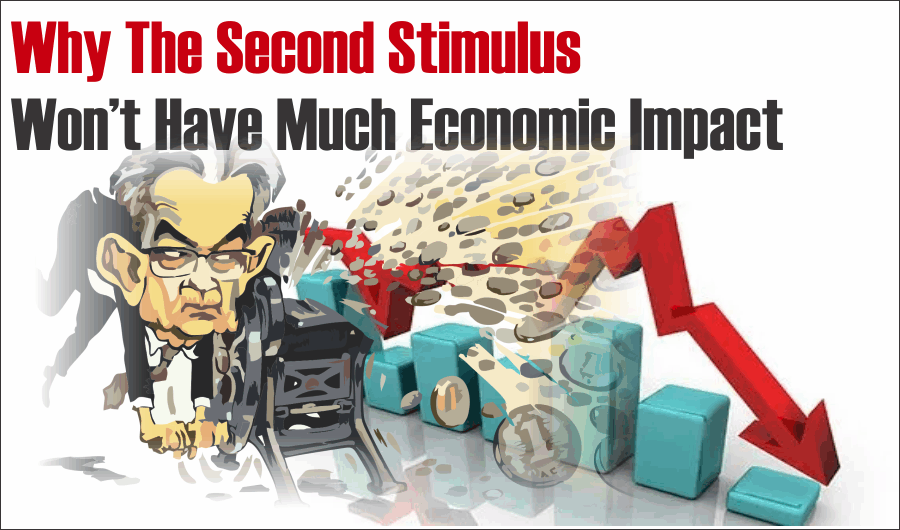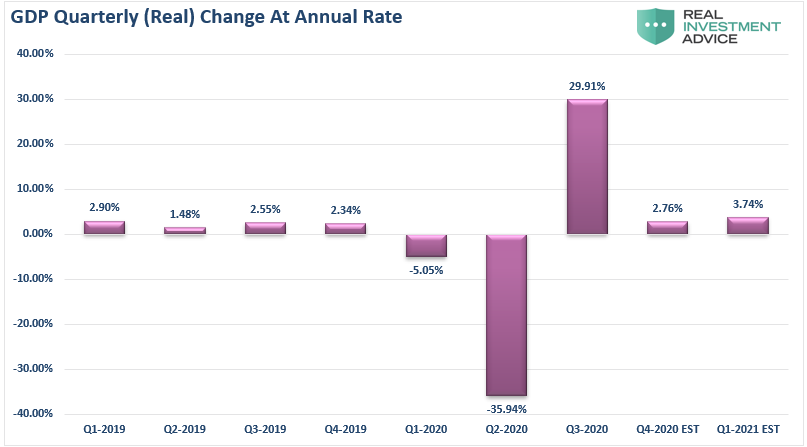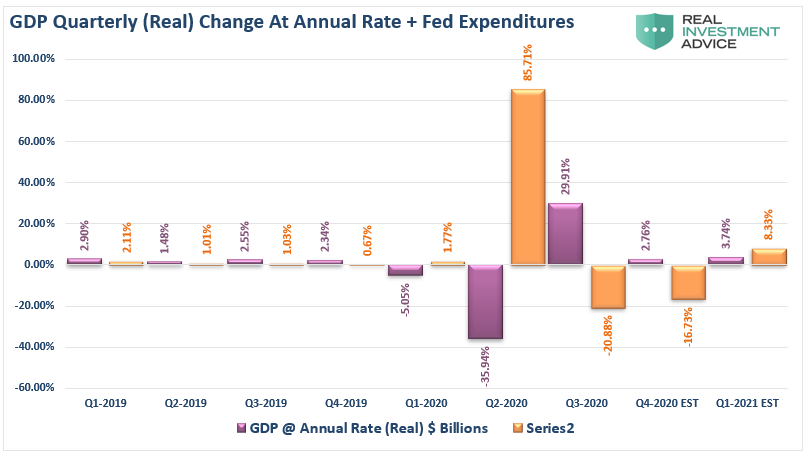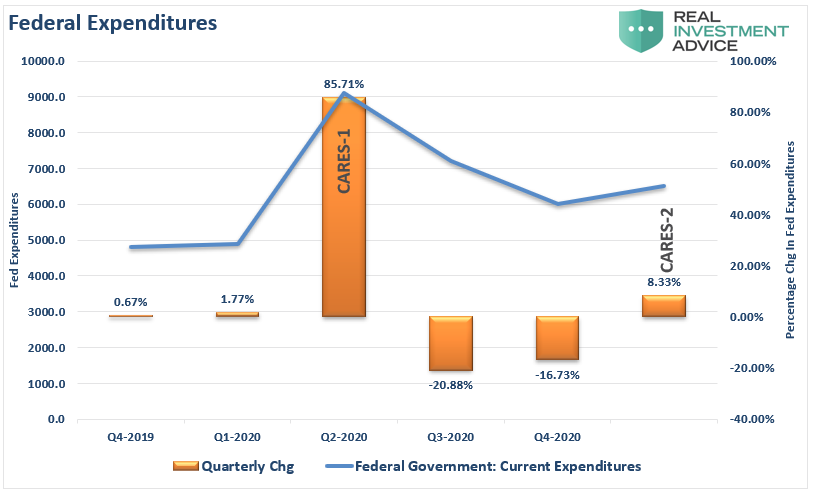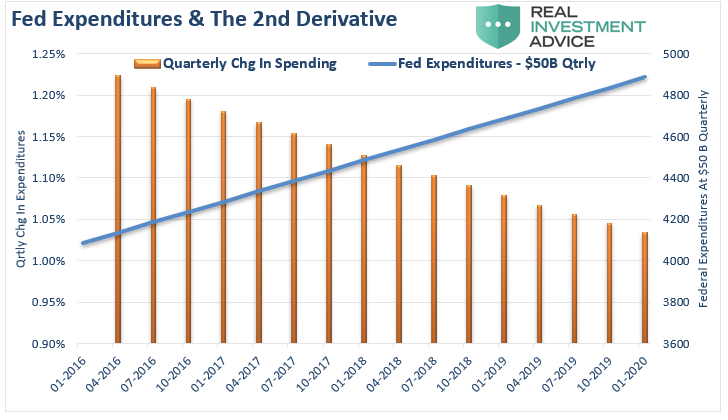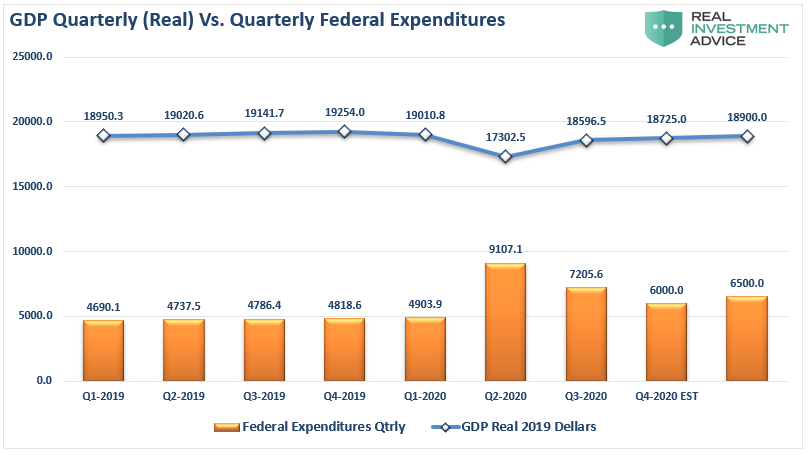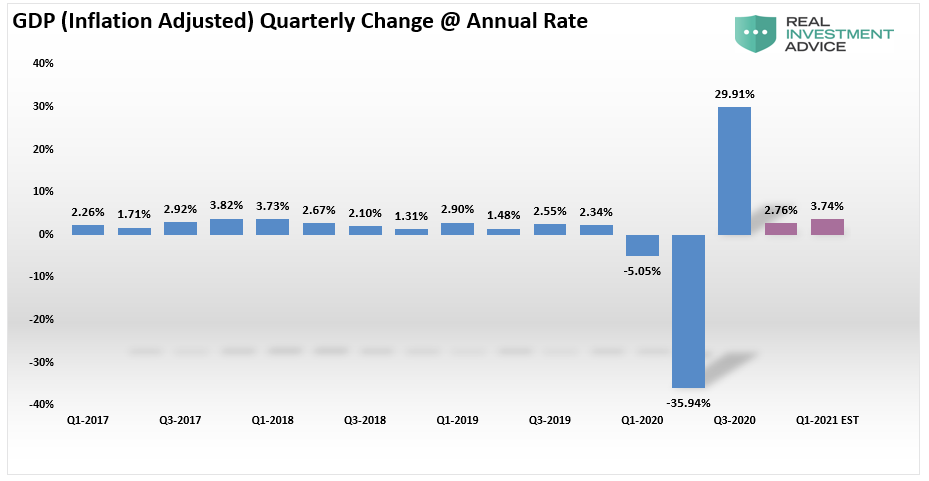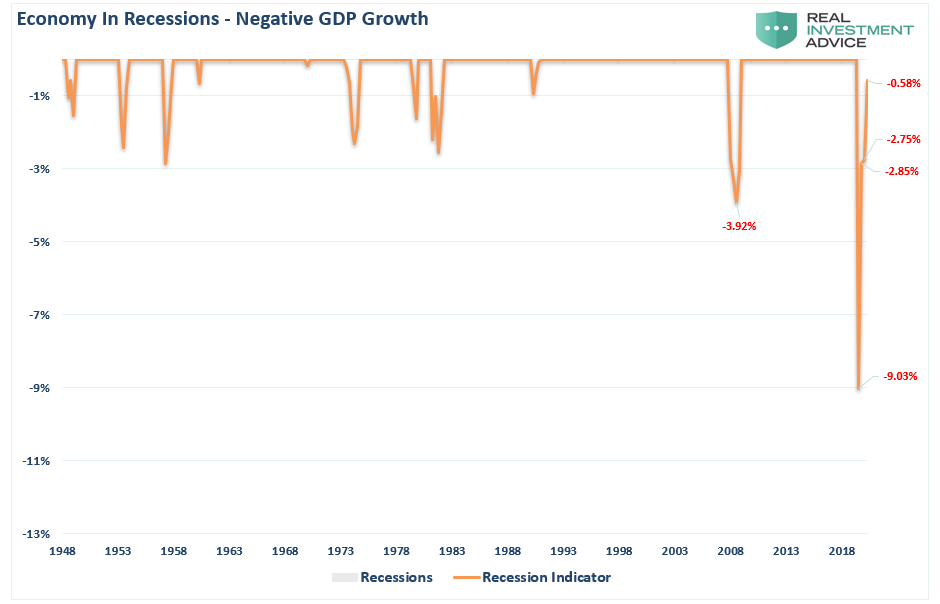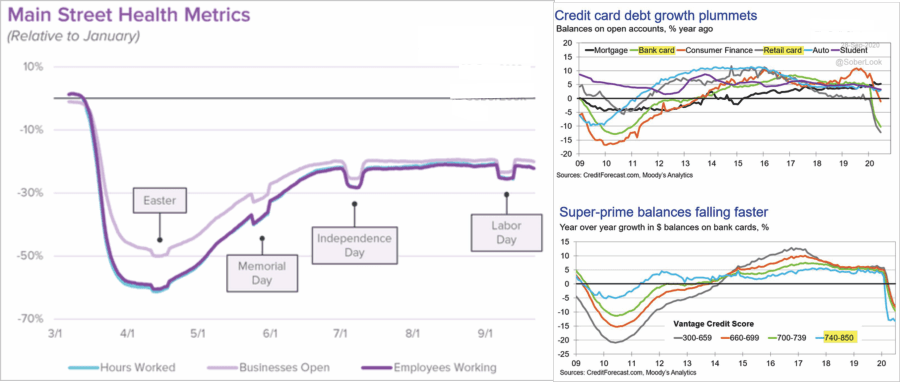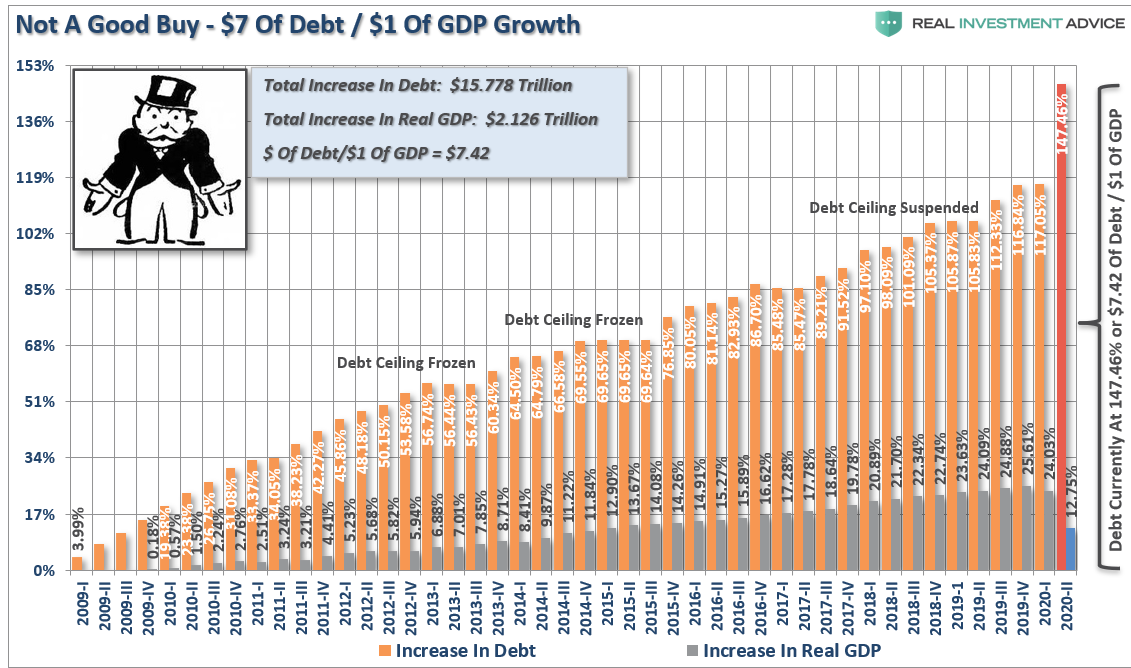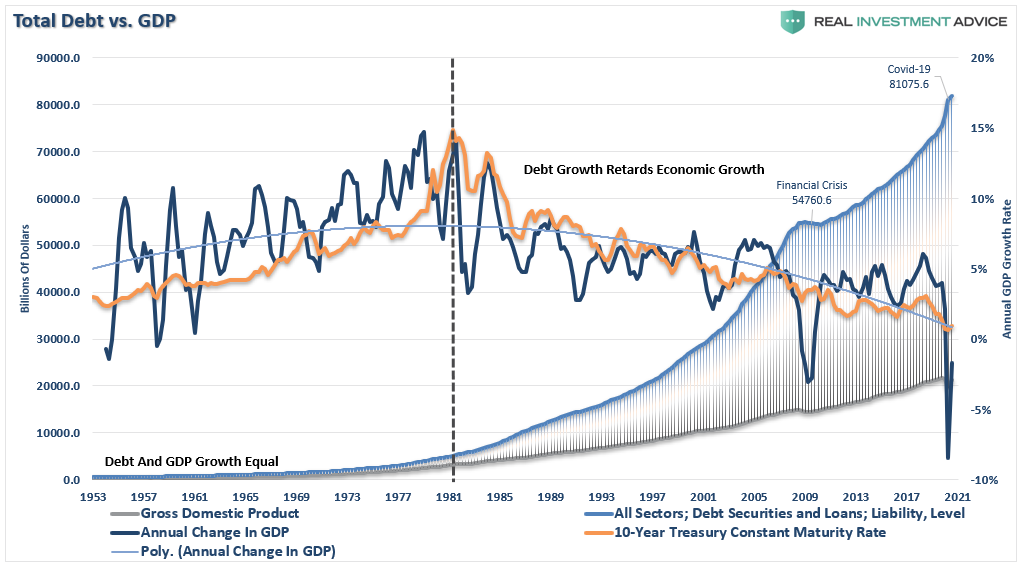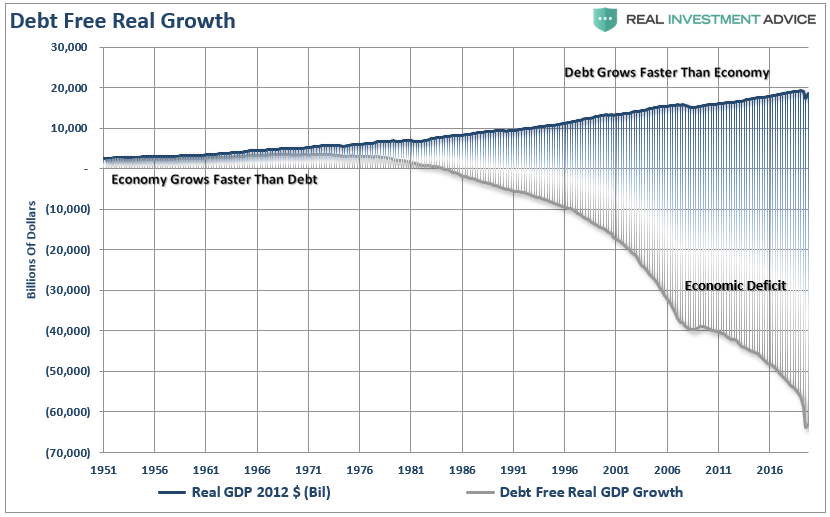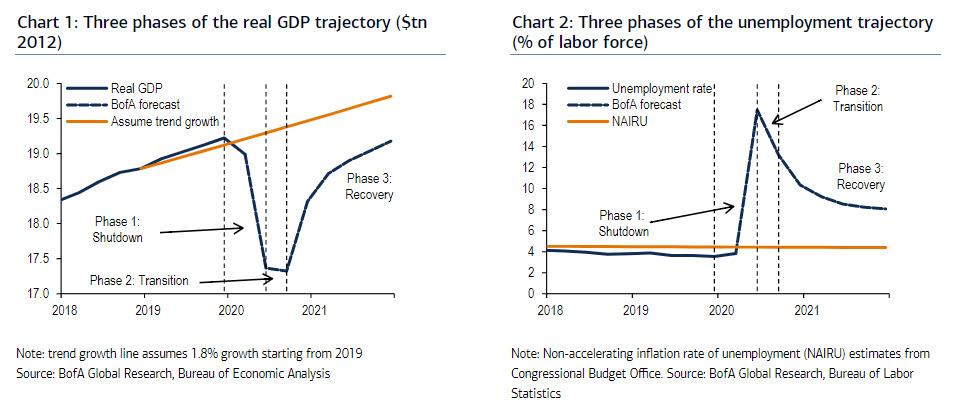In October, I discuss how the “2nd Derivative Effect” would mute the impact of future stimulus programs. With the passage of the $900 billion stimulus package, we can update the estimates for the economic impact heading into 2021.
While most hope more stimulus will cure the economy’s ills, the “2nd derivative effect” will be problematic. Of course, since vast portions of the stimulus package went to everything but “helping out the average American,” such ensures the impact will be far less.
Let me recap.
NOTE: This article was written prior to Trump’s rejection of the stimulus bill. The analysis is based on the bill as is currently written. I will update the analysis if the bill changes.
Making Some Assumptions
As the economy shut down due to the pandemic, the Federal Reserve flooded the system with liquidity in March. At the same time, Congress passed a massive fiscal stimulus bill that extended Unemployment Benefits by $600 per week and sent $1200 checks directly to households.
As shown in the chart below of GDP, it worked. In Q3, inflation-adjusted GDP surged 29.91% from the Q2 reading of 35.94%. If we assume that Q4 will increase according to the Atlanta Fed GDPNow estimate, GDP will slow to just a 2.76% advance.
Assuming the direct checks to households hit in January, GDP will rise slightly to 3.74%. In other words, the “2nd derivative effect” requires increasing amounts of Federal Expenditures to generate only marginally higher levels of economic growth.
The chart below adds the percentage change in Federal expenditures to the chart for comparison.
The spike in Q2 in Federal Expenditure was from the initial CARES Act. In Q1-2020, the Government spent $4.9 Trillion in total, which was up $85.3 Billion from Q4-2019. In Q2-2020, it increased sharply, including the passage of the CARES Act. Spending for Q2 jumped to $9.1 Trillion, which was a $4.2 Trillion increase over Q1-2020.
In Q3-2020, spending fell slightly to just $7.2 Trillion, which was down 20% from Q2. However, the $7.2 Trillion in expenditures was still $2.3 Trillion higher than in Q4-2019.
Those are the facts as published by the Federal Reserve. From this point forward, we have to start making some estimates and assumptions for Q4 and Q1-2021.
Impact Of CARES-2
During Q4-2020, not much happened as the Government was fighting over the next round of stimulus. As such, spending fell back to a more normal level of increase. However, if we assume the second CARES Act checks hit by January, it would represent a roughly 8.3% increase in Government spending over Q4-2020.
Such is the “second derivative” effect we mentioned previously.
“In calculus, the second derivative, or the second-order derivative, of a function f is the derivative of the derivative of f.” – Wikipedia
In English, the “second derivative” measures how the rate of change of a quantity is itself changing.
I know, still confusing.
Let’s run an example:
As Government spending grows sequentially larger, each additional round of expenditures will have less and less impact on the total. Going back to 2016, not including the CARES Act, the Government increased spending by roughly $50 billion each quarter on average. If we run a hypothetical model of Government expenditures at $50 billion per quarter, you can see the issue of the “second derivative.”
In this case, even though Federal expenditures are increasing at $50 Billion per quarter, the rate of change declines as the total spending increase.
More Leads To Less
The next chart shows how the “second derivative” is already undermining both fiscal and monetary stimulus. Using actual data going back to the Q1-2019, Federal Expenditures remained relatively stable through Q1-2020, along with real economic growth. However, in Q2-2020, with our estimates for Q3 and Q4, Federal Expenditures will almost double. However, the economy will not return to positive growth.
The chart below shows the inherent problem. While the additional fiscal stimulus may help stave off a more in-depth economic contraction, its impact becomes less over time.
However, this is ultimately the problem with all debt-supported fiscal and monetary programs.
Still In A Recession
As stated, even with the additional stimulus package, the outcome will be muted. If we assume our current estimates for GDP growth over the next 2-quarters, which align with mainstream consensus, we will still be in a recession.
At first glance, it appears that after one negative quarter of GDP, the economy is well back on track to normalcy. However, such an assumption would be incorrect. Given that we measure economic growth on an annualized basis, the three-quarters of positive change following such a steep decline still leaves the economy in a recession.
Yes, add a couple of more quarters of economic growth, and you will eventually be back into positive territory. However, therein lies an even bigger problem.
Dollars Of Growth Deteriorate
As noted above, it requires increasing levels of debt to generate lower rates of economic growth. The chart below shows the previous and estimated CARES Acts and their impact on GDP growth.
To understand this better, we can view it from how many dollars it requires to generate $1 of economic growth. Following the economic shutdown, when economic activity went to zero, each dollar of input had a more considerable impact as the economy restarted. However, in Q4, economic activity has already recovered and begun to stabilize at a slightly lower level than seen previously.
High-frequency data like credit card spending and main-street activity indicators tell us this is the case.
Given that stabilization of activity, it will require more dollars to generate economic growth in the future. As shown, it will need $7 of debt-supported expenditures to create $1 of economic growth.
Here is the exciting part. That is NOT a new thing. As I discussed just recently, “The One-Way Trip Of American Debt:”
The “COVID-19″ crisis led to a debt surge to new highs. Such will result in a retardation of economic growth to 1.5% or less, as discussed recently. Simultaneously, the stock market may rise due to massive Fed liquidity, but only the 10% of the population owning 88% of the market benefits. In the future, the economic bifurcation will deepen to the point where 5% of the population owns virtually all of it.
As I noted previously, it now requires $7.42 of debt to create $1 of economic growth, which will only worsen as the debt continues to expand at the expense of more robust rates of growth.
You Can’t Use Debt To Create Growth.
As noted above, more debt doesn’t lead to more robust rates of economic growth or prosperity. Since 1980, the overall increase in debt has surged to levels that currently usurp the entirety of economic growth. With economic growth rates now at the lowest levels on record, the change in debt continues to divert more tax dollars away from productive investments into the service of debt and social welfare.
Another way to view the impact of debt on the economy is to look at what “debt-free” economic growth would be. In other words, without debt, there has been no organic economic growth.
The economic deficit has never been more significant. For the 30 years from 1952 to 1982, the economic surplus fostered a rising economic growth rate, which averaged roughly 8% during that period. Such is why the Federal Reserve has found itself in a “liquidity trap.”
Interest rates MUST remain low, and debt MUST grow faster than the economy, just to keep the economy from stalling out.
The deterioration of economic growth is seen more clearly in the chart below.
From 1947 to 2008, the U.S. economy had real, inflation-adjusted economic growth than had a linear growth trend of 3.2%.
However, following the 2008 recession, the growth rate dropped to the exponential growth trend of roughly 2.2%. Unfortunately, instead of reducing outstanding debt problems, the Federal Reserve provided policies that fostered even greater unproductive debt and leverage levels.
Coming out of the 2020 recession, the economic trend of growth will be somewhere between 1.5% and 1.75%. Given the amount of debt added to the overall system, the ongoing debt service will continue to retard economic growth.
A Permanent Loss
As noted by Zerohedge, the permanent loss in output in the U.S. was shown by BofA previously. The bank laid out the pre-COVID trend growth and compared it to its base case recovery.
Such aligns closely with our analysis shown above. Given the permanent loss in output and rising unproductive debt levels, the recovery will be slower and more protracted than those hoping for a “V-shaped” recovery. The “Nike Swoosh,” while more realistic, might be overly optimistic as well.
However, this is the most critical point.
The U.S. economy will never return to either its long-term linear or exponential growth trends.
Read that again.
Pulling Forward Consumption Isn’t Sustainable.
If you read between the lines, policymakers are “spit-balling” solutions and making potentially erroneous monetary policy decisions on unreliable data.
However, the “trap” that lawmakers, along with the Fed, have now fallen into is that “stimulus” only pulls forward “future consumption.” As we saw after the initial CARES act, as soon as financial supports evaporated, so did economic growth.
The hope over the last decade was the economy would eventually “catch fire” grow organically. Such would allow Central Banks to reverse monetary supports. However, such has never occurred. Each time Central Banks reduce monetary supports, the economy stalls or worse.
It is likely that “something has gone wrong” for the Federal Reserve. The ability to pull-forward future consumption through monetary interventions has been reached. Despite ongoing hopes of “higher growth rates” in the future, such will likely not be the case until the debt overhang gets cleared.
We will likely remain constrained in the “spurt and sputter” growth cycle we have witnessed since 2009. We will continue to see volatile equity market returns and a stagflationary environment as wages remain suppressed while costs of living rise.
Due to the debt, demographics, and monetary and fiscal policy failures, the long-term economic growth rate will run well below long-term trends.
Such will ensure the widening of the wealth gap, increases in welfare dependency, and capitalism giving way to socialism.
